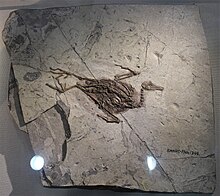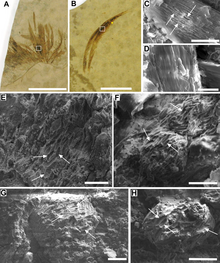Gansus
| Gansus Temporal range:Early Cretaceous,
| |
|---|---|

| |
| Fossil specimen,Beijing Museum of Natural History. | |
| Scientific classification | |
| Domain: | Eukaryota |
| Kingdom: | Animalia |
| Phylum: | Chordata |
| Clade: | Dinosauria |
| Clade: | Saurischia |
| Clade: | Theropoda |
| Clade: | Avialae |
| Clade: | Ornithuromorpha |
| Genus: | †Gansus Hou & Liu, 1984 |
| Type species | |
| †Gansus yumenensis Hou & Liu, 1984
| |
| Other species | |
| |
Gansusis agenusofaquatic birdsthat lived during theAptianage of the EarlyCretaceous(Aptian-Albian) period in what are nowGansuandLiaoningprovinces, westernChina.The rock layers from which their fossils have been recovered are dated to 120 million years ago.[1]It was first described in 1984 on the basis of an isolated left leg.[2]It is the oldest-known member of theOrnithurae,the group which includes modern birds (Neornithes) and extinct related groups, such asIchthyornisandHesperornithes.[2][3]
Description
[edit]
The genusGansuscontains a single species,G. yumenensis,[2]which was about the size of apigeonand similar in appearance toloonsanddiving ducks.[5]It had many features common among modern birds, and also retained some basal traits such as its clawed wings.[5]
Gansuswas discovered in the form of a single fossil foot in 1981. Five more well-preserved fossils were found in 2003–2004 inmudstoneat the site of an ancient lake at Changma, Gansu; the geological stratum in which the fossils were found is theXiagou Formation.Their bodies had settled in anoxic mud and were soon covered with further extremely fine silty sediments. Without oxygen, their remains resisted decay: these specimens preserved remains offlight feathersand traces of the webbing between their toes.[5]In 2011, there were described nine additional specimens, that supported on the basis of a statistic analysis of the sternum and elements of the legs, the hypothesis thatGansuswas a volant bird.[6]
Youet al.(2006) concluded that the anatomical characteristics ofGansuswere similar to foot-propelled diving birds, such asHesperornis(from theCretaceous) and the loons (Gaviidae) and grebes (Podicipedidae).[5]On the other hand, Liet al.(2011) concluded thatGansusshowed a more similar morphology to ducks.[6]Two years later, Nuddset al.(2013) showed that the pectoral limb length proportions ofGansuswere most similar to swifts and hummingbirds (Apodiformes), while the pelvic limb length proportions fell within the modern birds (Neornithes), showing similarities with grebes (Podicipedidae), albatross (Diomedeidae) and cormorants (Phalacrocoracidae), suggesting thatGansuswas both volant and capable of diving to some degree using either foot-propelled or, perhaps, both its wings and its feet for underwater locomotion.[7]
Classification
[edit]
Gansuswas described as the oldest knownornithuran.TheOrnithurae,however, has been given several very different definitions. In the definition used by You and colleagues (that is, thecladecontaining all living birds plusHesperornisandIchthyornis),Gansusis indeed the oldest known member. However, several birds from the olderYixian Formationand contemporaryJiufotang Formationare considered ornithurans under other definitions. Under any definition, all living birds, includingtaxaas diverse asostriches,hummingbirdsandeagles,are descended from basal ornithurans, many of which were semi-aquatic. It is now thought possible that all modern birds descended specifically from a semi-aquatic bird similar toGansus.Thus, whileGansusis not necessarily a direct ancestor of today's birds, it is closely related to such an ancestral species.[5]This hypothesis was corroborated by later phylogenetic studies that included this taxon.[3][8]
References
[edit]- ^Ji, S.-A. Atterholt, J. O'Connor, J.K. Lamanna, M.C. Harris, J.D. Li, D.-Q. You, H.-L. & Dodson, P. (2011)A new, three-dimensionally preserved enantiornithine bird (Aves: Ornithothoraces) from Gansu Province, north-western China.Zoological Journal of the Linnean Society162(1):201–219.
- ^abcHou, L. & Liu, Z. (1984) A new fossil bird from Lower Cretaceous of Gansu and early evolution of birds.Sci. Sin. Ser. B.27:1296−1302.
- ^abO’Connor, J.K & Zhou, Z. (2012)A redescription ofChaoyangia beishanensis(Aves) and a comprehensive phylogeny of Mesozoic birds.Journal of Systematic Palaeontology.
- ^Barden, H.E.et al.(2011) Morphological and Geochemical Evidence of Eumelanin Preservation in the Feathers of the Early Cretaceous Bird,Gansus yumenensis.PLoS ONE6(10):e25494.
- ^abcdeYou, H.-L. Lamanna, M.C. Harris, J.D. Chiappe, L.M. O'Connor, J.K. Ji, S.-A. Lu, J.-C. Yuan, C.-X. Li, D.-G. Zhang, X. Lacovara, K.J. Dodson, P. & Ji, Q. (2006)A Nearly Modern Amphibious Bird from the Early Cretaceous of Northwestern China.Science312:1640-1643.
- ^abLi, Y. Zhang, Y.-G. Zhou, Z.-H. Li, Z.-H. Liu, D. & Wang, X.-L. (2011) New material ofGansusand a discussion on its habit.Vert. PalAs49:435–445.
- ^Nudds, R.L, Atterholt, J. Wang, X. You, H.-L. & Dyke, G.J. (2013)Locomotory abilities and habitat of the Cretaceous birdGansus yumenensisinferred from limb length proportions.Journal of Evolutionary Biology26(1):150–154.
- ^O'Connor, J.K., Gao, K.-Q. & Chiappe, L.M. (2010) A new ornithuromorph. (Aves: Ornithothoraces) bird from the Jehol Group indicative of higher− level diversity.Journal of Vertebrate Paleontology30:311–321.










